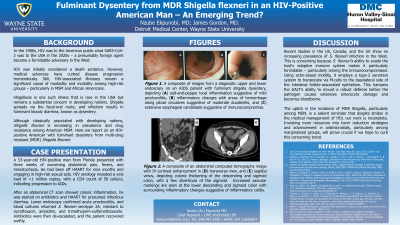Sunday Poster Session
Category: Small Intestine
P1296 - Fulminant Dysentery from MDR Shigella Flexneri in an HIV-Positive American Man – An Emerging Trend?
Sunday, October 22, 2023
3:30 PM - 7:00 PM PT
Location: Exhibit Hall

Has Audio

Nzube Ekpunobi, MD
Detroit Medical Center
Farmington Hills, MI
Presenting Author(s)
Nzube Ekpunobi, MD
Detroit Medical Center, Farmington Hills, MI
Introduction: In the 1980s, HIV was to the American public what SARS-CoV-2 was to the USA in the 2020s - a presumably foreign agent became a formidable adversary in the West. HIV was initially considered a death sentence, but medical advances have curbed disease progression tremendously. Still, HIV-associated illnesses remain a significant cause of morbidity and mortality among high-risk groups – particularly men who have sex with men (MSM) and African Americans. Shigellosis is one such illness that is rare in the USA but remains a substantial concern in developing nations. Shigella spreads via the fecal-oral route, and infection results in fulminant bloody diarrhea, known as dysentery. Although classically associated with developing nations, <em>Shigella flexneri</em> is increasing in prevalence and drug resistance among American MSM. Here we report on an HIV-positive American with fulminant dysentery from multi-drug resistant (MDR) Shigella flexneri.
Case Description/Methods: A 53-year-old HIV-positive man from Florida came to the hospital after three weeks of worsening abdominal pain, fevers, and hematochezia. He had been off HAART for nine months and engaging in high-risk sexual acts. HIV serology revealed a viral load of >1 million copies, with a CD4 count of 50 cells/UL indicating progression to AIDs.
After an abdominal CT scan showed colonic inflammation, he was started on antibiotics and HAART for presumed infectious diarrhea. Lower endoscopy confirmed acute proctocolitis, and blood cultures returned S. flexneri serotype 2A, resistant to ciprofloxacin, ampicillin, and trimethoprim-sulfamethoxazole. Antibiotics were then narrowed, and the patient recovered swiftly.
Discussion: Recent studies in the US, Canada, and the UK have shown an increasing prevalence of S. flexneri infection in the West. This is concerning because S. flexneri's ability to evade the host's adaptive immune system makes it particularly formidable. Using actin-based motility, it uses a type-3 secretion system to translocate via M-cells to the basolateral side of the intestinal follicle-associate epithelium. This hampers the GALT's ability to mount a robust defense before the pathogen causes extensive enterocyte damage and becomes bloodborne.
The uptick in the incidence of MDR Shigella, particularly among MSM, is a salient reminder that despite strides in the medical management of HIV, our work is incomplete. Therefore, harm reduction strategies and advancement in antimicrobials will prove crucial if we hope to curb this concerning trend.

Disclosures:
Nzube Ekpunobi, MD. P1296 - Fulminant Dysentery from MDR Shigella Flexneri in an HIV-Positive American Man – An Emerging Trend?, ACG 2023 Annual Scientific Meeting Abstracts. Vancouver, BC, Canada: American College of Gastroenterology.
Detroit Medical Center, Farmington Hills, MI
Introduction: In the 1980s, HIV was to the American public what SARS-CoV-2 was to the USA in the 2020s - a presumably foreign agent became a formidable adversary in the West. HIV was initially considered a death sentence, but medical advances have curbed disease progression tremendously. Still, HIV-associated illnesses remain a significant cause of morbidity and mortality among high-risk groups – particularly men who have sex with men (MSM) and African Americans. Shigellosis is one such illness that is rare in the USA but remains a substantial concern in developing nations. Shigella spreads via the fecal-oral route, and infection results in fulminant bloody diarrhea, known as dysentery. Although classically associated with developing nations, <em>Shigella flexneri</em> is increasing in prevalence and drug resistance among American MSM. Here we report on an HIV-positive American with fulminant dysentery from multi-drug resistant (MDR) Shigella flexneri.
Case Description/Methods: A 53-year-old HIV-positive man from Florida came to the hospital after three weeks of worsening abdominal pain, fevers, and hematochezia. He had been off HAART for nine months and engaging in high-risk sexual acts. HIV serology revealed a viral load of >1 million copies, with a CD4 count of 50 cells/UL indicating progression to AIDs.
After an abdominal CT scan showed colonic inflammation, he was started on antibiotics and HAART for presumed infectious diarrhea. Lower endoscopy confirmed acute proctocolitis, and blood cultures returned S. flexneri serotype 2A, resistant to ciprofloxacin, ampicillin, and trimethoprim-sulfamethoxazole. Antibiotics were then narrowed, and the patient recovered swiftly.
Discussion: Recent studies in the US, Canada, and the UK have shown an increasing prevalence of S. flexneri infection in the West. This is concerning because S. flexneri's ability to evade the host's adaptive immune system makes it particularly formidable. Using actin-based motility, it uses a type-3 secretion system to translocate via M-cells to the basolateral side of the intestinal follicle-associate epithelium. This hampers the GALT's ability to mount a robust defense before the pathogen causes extensive enterocyte damage and becomes bloodborne.
The uptick in the incidence of MDR Shigella, particularly among MSM, is a salient reminder that despite strides in the medical management of HIV, our work is incomplete. Therefore, harm reduction strategies and advancement in antimicrobials will prove crucial if we hope to curb this concerning trend.

Figure: Diagnostic endoscopy in an AIDS patient demonstrating (A) mild infectious proctocolitis, (B) duodenitis, and (C) esophageal candidiasis.
Disclosures:
Nzube Ekpunobi indicated no relevant financial relationships.
Nzube Ekpunobi, MD. P1296 - Fulminant Dysentery from MDR Shigella Flexneri in an HIV-Positive American Man – An Emerging Trend?, ACG 2023 Annual Scientific Meeting Abstracts. Vancouver, BC, Canada: American College of Gastroenterology.
